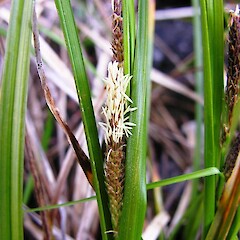Carex dolomitica
Common name
Mt Burnett sedge
Synonyms
None
Family
Cyperaceae
Flora category
Vascular – Native
Endemic taxon
Yes
Endemic genus
No
Endemic family
No
Structural class
Sedges
NVS code
The National Vegetation Survey (NVS) Databank is a physical archive and electronic databank containing records of over 94,000 vegetation survey plots - including data from over 19,000 permanent plots. NVS maintains a standard set of species code abbreviations that correspond to standard scientific plant names from the Ngä Tipu o Aotearoa - New Zealand Plants database.
CARDOL
Chromosome number
2n = c.72
Current conservation status
The conservation status of all known New Zealand vascular plant taxa at the rank of species and below were reassessed in 2017 using the New Zealand Threat Classification System (NZTCS) – more information about this can be found on the NZTCS website. This report includes a statistical summary and brief notes on changes since 2012 and replaces all previous NZTCS lists for vascular plants.
Please note, threat classifications are often suggested by authors when publications fall between NZTCS assessment periods – an interim threat classification status has not been assessed by the NZTCS panel.
- Conservation status of New Zealand indigenous vascular plants, 2017 . 2018. Peter J. de Lange, Jeremy R. Rolfe, John W. Barkla, Shannel P. Courtney, Paul D. Champion, Leon R. Perrie, Sarah M. Beadel, Kerry A. Ford, Ilse Breitwieser, Ines Schönberger, Rowan Hindmarsh-Walls, Peter B. Heenan and Kate Ladley. Department of Conservation. Source: NZTCS and licensed by DOC for reuse under the Creative Commons Attribution 4.0 International licence.
2017 | Threatened – Nationally Critical | Qualifiers: CD, OL
Previous conservation statuses
2012 | Threatened – Nationally Critical | Qualifiers: CD, OL
2009 | Threatened – Nationally Critical | Qualifiers: CD, OL
2004 | Threatened – Nationally Critical
Distribution
Endemic. South Island, where it is known only from Mt Burnett. There it grows on both North and South Peaks.
Habitat
Confined to open or exposed areas of dolomite and dolomite/ limestone/marble karrenfield with little associated vegetation. Plants have also colonised the mining roads and old quarry.
Detailed description
Robust, tussock-forming, bronze-green sedge with channelled leaves. Leaves 200–600 × 4–8.5 mm, rigid, erect, channelled, green. Culms 400–850 mm long, stout, ascending or spreading, rigid, trigonous, longer than leaves when mature. Basal sheaths up to 60 mm long, dark brown or black, nerves distinct. Spikes 4–8, up to 40 mm long, erect, upper spikes approximate and sessile, lower 1–(2) spikes distant, shortly pedunculate; spikes subtended by narrow, leaf-like bracts; terminal 1–(2) spikes male; female spikes cylindrical, with three stigmas. Glumes 3.3–3.8 × 1.5–2.3 mm, similar length , or shorter than utricles, ovate, elliptic, chestnut brown at base, pale brown above, persistent, 2-lobed at apex, midrib green, awn 0.2–1 mm, weakly scabrid, green. Utricles 3.2–4.2 × 1.3–1.9 mm, glabrous, broad-ovoid to ovoid, elliptic or narrowly-elliptic, plano-convex or subtrigonous, black with a pale brown stipe and beak; beak 0.3–0.5 mm.
Similar taxa
Perhaps closest to C. dallii Kirk, from which differs in its wine red, finer (1–2 mm wide) leaves, and narrower female spikes. However, several as yet unnamed carices are closely allied to C. dolomitica, and further work is needed to resolve the relationships between these plants.
Flowering
November
Fruiting
November–September
Life cycle
Nuts surrounded by inflated utricles are dispersed by granivory and wind (Thorsen et al., 2009).
Propagation technique
Easy to grow from divisions of whole plants and from fresh seed. An attractive, robust sedge that does well in full sun. It likes a fertile soil and can tolerate free-draining conditions and/or some waterlogging. An excellent rockery plant.
Threats
Carex dolomitica is at serious risk from dolomite mining which is destroying its only known habitat faster than it can recolonise old mine workings. This sedge is also threatened from competition from weeds such as Mexican daisy (Erigeron karvinskianus) which have colonised Mt Burnett. Carex dolomitica is the only dolomite endemic to have successfully colonised the mine roads.
Etymology
carex: Latin name for a species of sedge, now applied to the whole group.
Where To Buy
Not commerically available. Some plants are held privately and by at least one Botanic Garden.
Attribution
Fact sheet prepared for NZPCN by P.J. de Lange 1 October 2003. Description adapted from Heenan & de Lange (1997).
References and further reading
Heenan PB, de Lange PJ. 1997. Carex dolomitica (Cyperaceae), a new and rare species from New Zealand. New Zealand Journal of Botany 35(4): 423–428. https://doi.org/10.1080/0028825X.1987.10410166.
Thorsen MJ, Dickinson KJM, Seddon PJ. 2009. Seed dispersal systems in the New Zealand flora. Perspectives in Plant Ecology, Evolution and Systematics 11: 285–309.
NZPCN Fact Sheet citation
Please cite as: de Lange, P.J. (Year at time of access): Carex dolomitica Fact Sheet (content continuously updated). New Zealand Plant Conservation Network. https://www.nzpcn.org.nz/flora/species/carex-dolomitica/ (Date website was queried)





